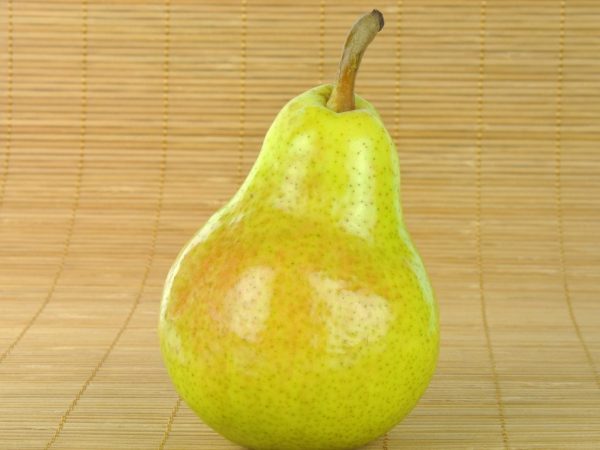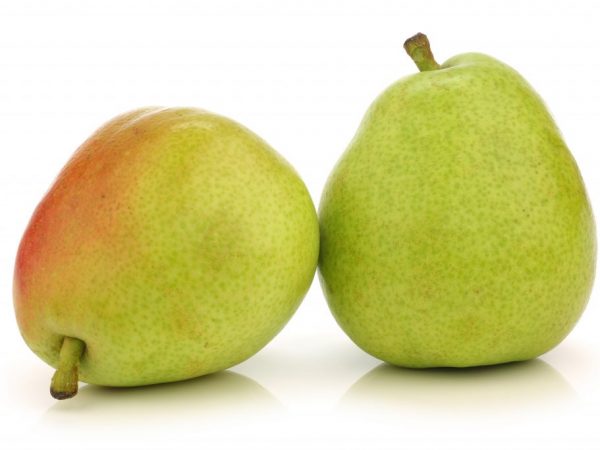Characteristics of pear varieties Gera
The Hera pear is resistant to severe frosts. It is appreciated for the sweet, tasty fruits that can be consumed during the diet, as well as for small children in the process of complementary feeding. We will consider a detailed description in the article.

Characteristics of pear varieties Gera
Variety characteristic
Pear Gera appeared as a result of crossing the Daughter of Dawn and Reale Turin varieties. This variety belongs to late ripening fruit trees. The absolute ripeness of the tree is reached only by the end of September.
Differs in good fertility and resistance to low temperatures. The fruit is fully ripe at the end of September. Also, this variety has a surprisingly long shelf life (subject to the necessary conditions) - up to 170 days. Begins to bear fruit in the 4th year after planting the seedling.
Another advantage of the variety is frost resistance. The tree does not freeze even at -30 ° C.
The varieties are self-fertile. For a richer harvest, you need to plant other varieties of late pears nearby. Another option is artificial pollination.
Description of the tree
Fruiting is medium in nature - fruits appear on both old and annual branches. According to the description of the tree, the crown is neat, pyramidal in shape. The average plant height is up to 5-7 m.Differs in the following features:
- shoots of a straight structure;
- the color of the fruit is brown;
- roughness is absent;
- a small amount of lentils.
The foliage is characterized by an oval shape and a rich greenish color. A sheet of medium size and curved shape. Small teeth are located along the edges. The surface of the sheet is not fleecy. The petioles are of medium length and thickness.
Description of fruits
The fruits of the Gera pear variety are quite large in shape. Average weight is about 300 gr. The shape of the fruit is round. The fruit is covered with a rough skin of medium density.
The color ranges from yellow to red with green tints. Sometimes a brownish mesh coating appears.
The peduncle is small, curved to the side. The funnel is so small that it is almost invisible. the pear cup is open.
The core is small and oval in shape. The seeds of the fruit are brown, located in the inner seed holes.
The pulp has the following characteristics:
- slightly granular;
- beige;
- has a sweet taste with sourness.
The pear contains about 10% sugar, so the taste of the fruit is not too cloying.
Pears, unlike apples, are not stored for long. Great for making jams, mashed potatoes, juices, jams, marmalades. Also, the fruits are quite popular in the manufacture of alcoholic products - tinctures, wines, liqueurs.
Care

We plant seedlings in the fall
In regions with moderate climatic conditions, seedlings are usually buried in the fall. The place for the pit should be chosen carefully, taking into account the height of the pear. It is recommended to plant a tree at a distance of 4 m from fences or other structures.
Pick-up location
The landing site should be dug into the depth of at least 1 m, and with a diameter of 80 cm.If the soil is sandy, then it is necessary to add humus mixed with 2 buckets of peat. The most favorable soils for growth are loam or black soil.
The planting pit is prepared at least a week in advance. It is not enough just to dig it up. You will need to add to the pit:
- fertilizers (humus);
- coarse sand;
- 1 bucket of water;
- 3 tbsp. tablespoons of potassium sulfate.
Stir the humus thoroughly and add 3 buckets of water. After a week, the pit will be absolutely ready for planting a seedling. Only planted Hera trees do not take root well and grow relatively slowly during the first 3 years. It is believed to be the result of an underdeveloped rhizome.
For the first month, seedlings need abundant moisture, loosening the soil, pruning the crown. Due to its frost resistance, the tree does not need to be insulated in any way in winter. Only annual seedlings need warmth.
During frosts, the trunk is covered with snow. Such insulation is sufficient. Large trees should also be covered with snow.
Watering
After a couple of years, Gera's pear will still need additional watering.
The tree needs frequent watering three times a year:
- before flowering;
- at the beginning of the emergence of fruits;
- after harvest.
In dry times, it is necessary to water the tree over and above the schedule - twice a week. It is not recommended to water the fruit trees during the sun, as the roots will absorb moisture better.
Pruning
Pruning of a Gera tree is usually done according to the following rules:
- densely overgrown places are thinned out for the free flow of oxygen;
- so that the tree is not too tall, a quarter of the trunk is usually cut off;
- after cutting the place of breakage, it is necessary to treat it with special substances (1% copper sulfate and after a while grease it with garden varnish);
- all dry branches must be broken off immediately, as well as get rid of branches that are located at right angles.
It is strictly forbidden to leave even small hemp. The branches are cut off at the root.
Mulching
Young trees need soil mulching with fertilizers (manure, peat). A similar procedure must be done in the fall.
Fertilizers are placed in dug holes (about 30-40 cm) around the tree trunk. For the Gera pear, the addition of phosphorus or potassium is beneficial. They must be added once every 5 years.
Diseases and pests
The Gera variety has good scab immunity. However, there are other ailments that are dangerous to the tree's fertility:
- black cancer - absolutely harm is done to the entire tree trunk;
- moniliosis - under the influence of a pest, the fruit on the tree rots, not yet ripe;
- bacterial burns - the tree dies immediately;
- rust - because of it, leaves fall off earlier.
In order to prevent these diseases, the minimum care rules must be followed. First of all, this is the harvesting of rotten fruits and fallen leaves, since this waste is the home of many parasites - moths, aphids, ticks.
Also, we must not forget about the annual coloring of the tree with lime. This will protect the trunk from pests.
In case of illness, it is important to carry out immediate chemical spraying:
- against rust and moniliosis - 1% Bordeaux mixture;
- against cancer - Calypso insecticide;
- foundazol and sulfite are universal remedies.
It is worth noting that the last drugs are not only medicines for ailments, but also good preventive measures.
Conclusion
The Gera pear variety is popular for its resistance to sudden changes in temperature. Provide the crop with the necessary care to produce excellent tasting fruits.

